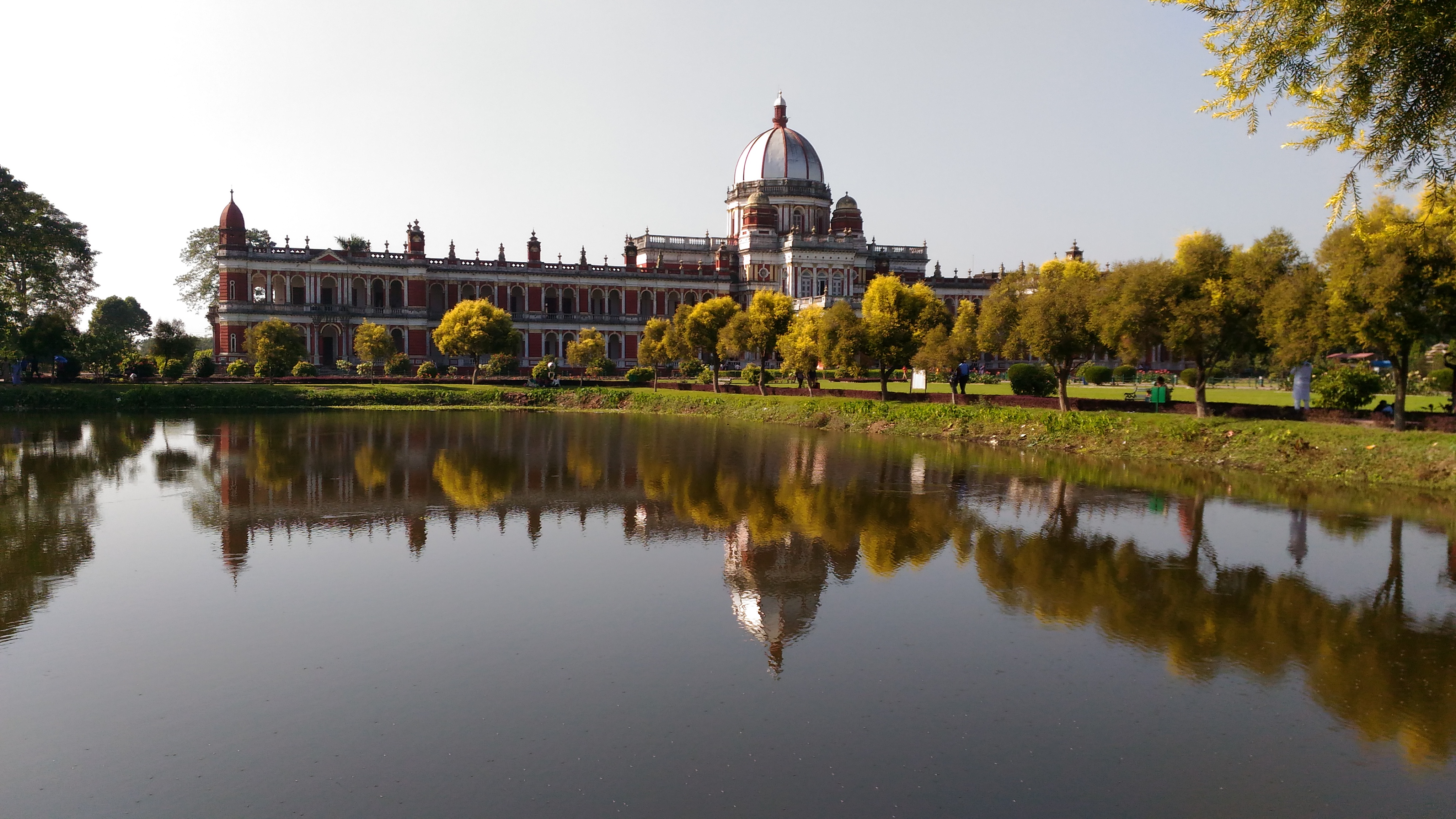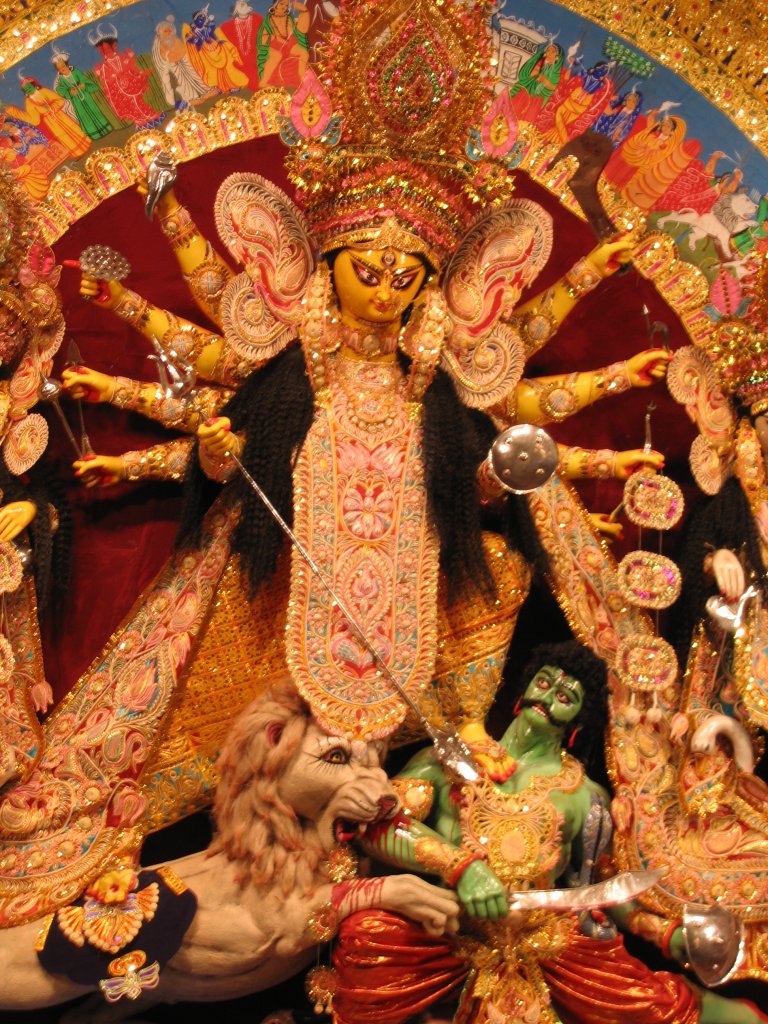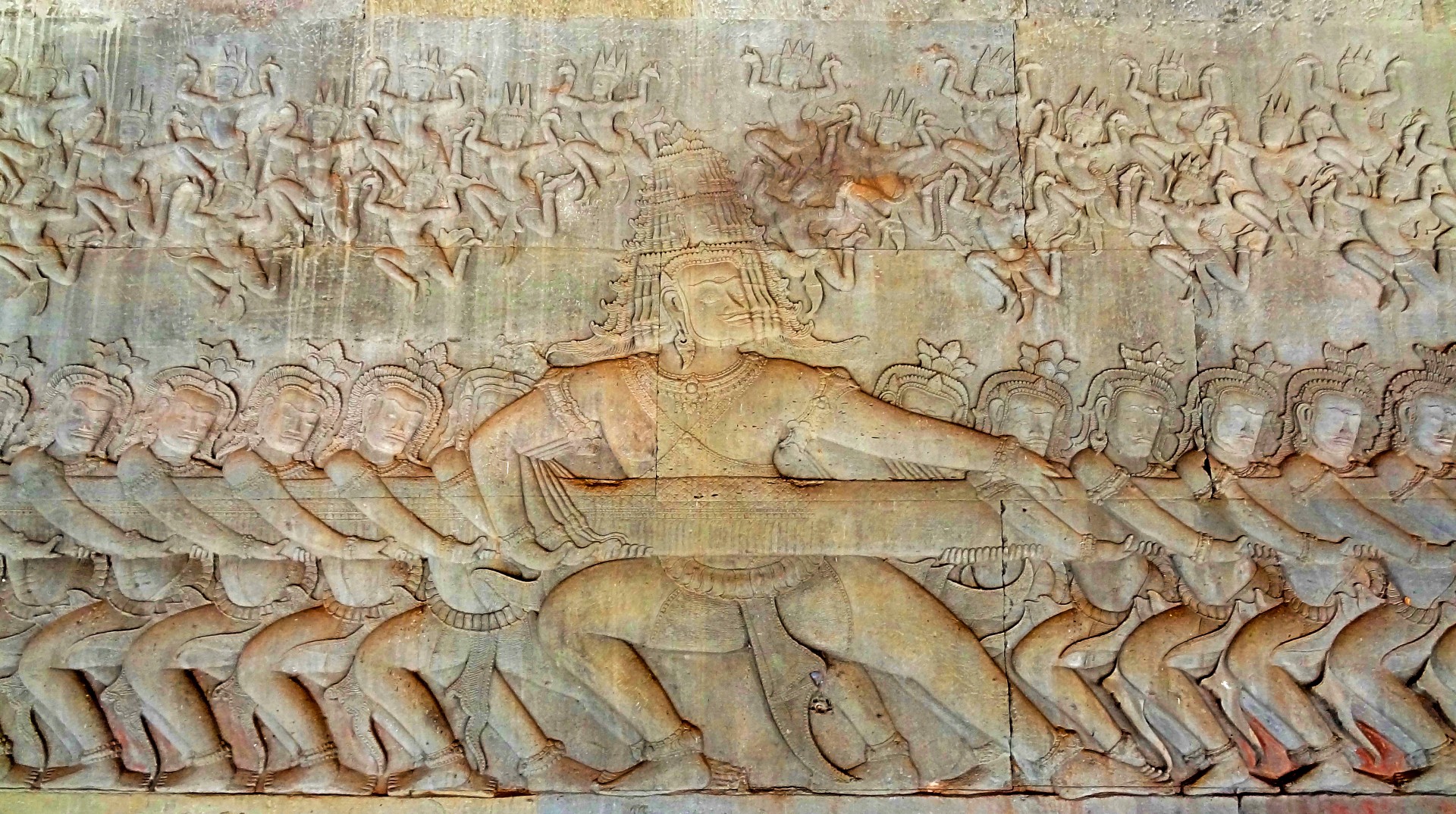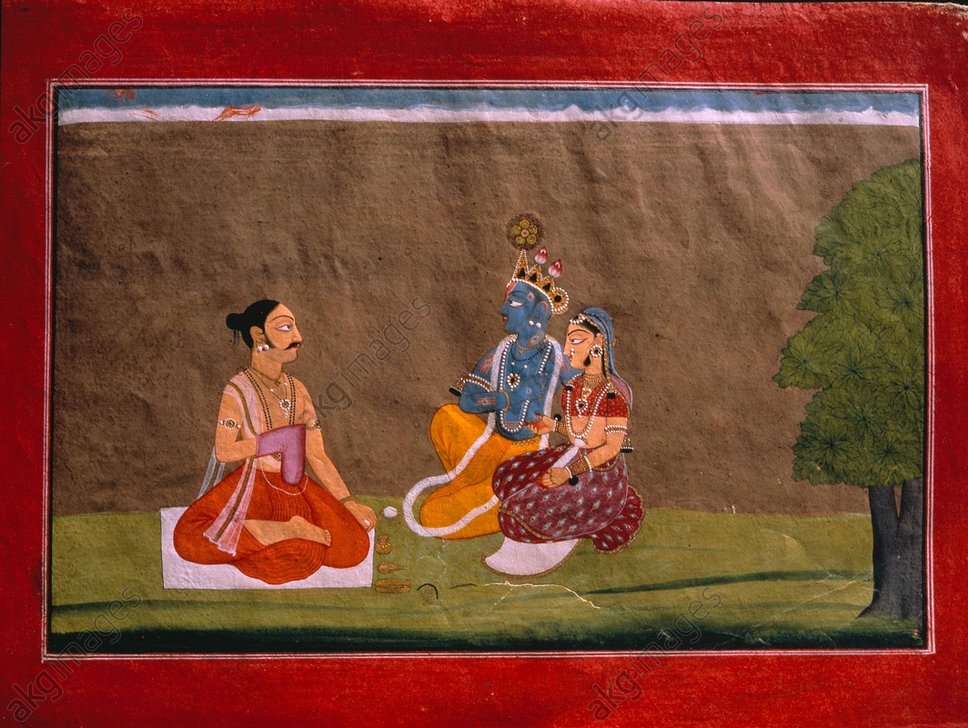|
Madan Mohan Temple, Cooch Behar
Madan Mohan Temple is a Hindu temple dedicated to the Lord Krishna, who is worshipped in the form of Madan Mohan in this temple. Maa Kali, Maa Tara and Maa Bhavani are the other major Hindu deities who are also worshipped in the temple. Situated in the heart of Cooch Behar town in Cooch Behar district of West Bengal, the temple has been a centerpiece of devotion and spiritual significance since its establishment in late 19th century by Maharaja Nripendra Narayan of the Koch dynasty. Besides being a house of worship, the temple and its architecture also serve as a landmark in the timeline of Cooch Behar's princely state. History Madan Mohan Temple was established by Maharaja Nripendra Narayan of the Koch dynasty in the late 19th century. Madan Mohan is the kuladevata of the Koch dynasty and hence over time, Shree Madan Mohan also became the primely worshipped deity of most of the Hindu people in the Cooch Behar district. The temple was constructed over 5 years between 1885 ... [...More Info...] [...Related Items...] OR: [Wikipedia] [Google] [Baidu] |
West Bengal
West Bengal (; Bengali language, Bengali: , , abbr. WB) is a States and union territories of India, state in the East India, eastern portion of India. It is situated along the Bay of Bengal, along with a population of over 91 million inhabitants within an area of as of 2011. The population estimate as of 2023 is 99,723,000. West Bengal is the List of states and union territories of India by population, fourth-most populous and List of states and union territories of India by area, thirteenth-largest state by area in India, as well as the List of first-level administrative divisions by population, eighth-most populous country subdivision of the world. As a part of the Bengal region of the Indian subcontinent, it borders Bangladesh in the east, and Nepal and Bhutan in the north. It also borders the Indian states of Jharkhand, Odisha, Bihar, Sikkim and Assam. The state capital is Kolkata, the List of metropolitan areas in India, third-largest metropolis, and List of cities in I ... [...More Info...] [...Related Items...] OR: [Wikipedia] [Google] [Baidu] |
Koch Dynasty
The Koch dynasty (; 1515–1949) ruled parts of eastern Indian subcontinent in present-day Assam and Bengal. Biswa Singha established power in the erstwhile Kamata Kingdom which had emerged from the decaying Kamarupa Kingdom. The dynasty came to power by overthrowing the Baro-Bhuyans of the region, who had previously ended the brief rule established by the invader Alauddin Hussain Shah. The dynasty split into three among the descendants of Biswa Singha's three sons: two antagonistic branches Koch Bihar and Koch Hajo and a third branch at Khaspur. Koch Bihar aligned with the Mughals and the Koch Hajo branch broke up into various sub-branches under the Ahom kingdom. Koch Bihar became a princely state during British rule and was absorbed after Indian independence. The third branch at Khaspur (Khaspur kingdom) was absorbed completely into the Kachari kingdom. Raikat is a collateral branch of the Koch dynasty that claim descent from the Sisya Singha, the brother of Bisw ... [...More Info...] [...Related Items...] OR: [Wikipedia] [Google] [Baidu] |
Durga Puja
Durga Puja (ISO 15919, ISO: , ), also known as Durgotsava or Shaaradotsava, is an annual festival originating in the Indian subcontinent which pays homage to the Hinduism, Hindu goddess Durga, and is also celebrated because of Durga's victory over Mahishasura. It is the biggest festival of Bengali Hindus and the Indian state of West Bengal. Durga Puja in Kolkata, Durga Puja as celebrated in Kolkata, West Bengal's capital city, was inscribed on the UNESCO Intangible Cultural Heritage Lists, intangible cultural heritage list of UNESCO in December 2021. In addition to West Bengal, Hindu Bengalis are native to Bangladesh and Indian state of Tripura, Barak Valley, Assam (Barak Valley), Jharkhand and Kosi-Seemanchal, Bihar (Kosi-Seemanchal); Therefore, Durga Puja is performed with great devotion in these places as well. The festival is observed in the Indian calendar in the month of Ashwin, Ashvin, which corresponds to September–October in the Gregorian calendar. Durga Puja is ... [...More Info...] [...Related Items...] OR: [Wikipedia] [Google] [Baidu] |
Durga
Durga (, ) is a major Hindu goddess, worshipped as a principal aspect of the mother goddess Mahadevi. She is associated with protection, strength, motherhood, destruction, and wars. Durga's legend centres around combating evils and demonic forces that threaten peace, prosperity, and dharma, representing the power of good over evil. Durga is believed to unleash her divine wrath against the wicked for the liberation of the oppressed, and entails destruction to empower creation. Durga is seen as a motherly figure and often depicted as a beautiful woman, riding a lion or tiger, with many arms each carrying a weapon and often defeating demons. She is widely worshipped by the followers of the goddess-centric sect, Shaktism, and has importance in other denominations like Shaivism and Vaishnavism. The most important texts of Shaktism, Devi Mahatmya and Devi Bhagavata Purana, revere Devi (the Goddess) as the primordial creator of the universe and the Brahman (ultimate truth and reali ... [...More Info...] [...Related Items...] OR: [Wikipedia] [Google] [Baidu] |
Asura
Asuras () are a class of beings in Indian religions, and later Persian and Turkic mythology. They are described as power-seeking beings related to the more benevolent Devas (also known as Suras) in Hinduism. In its Buddhist context, the word is translated as "titan" or " antigod". According to Hindu texts, the asuras are in constant fear of the devas. Asuras are described in Indian texts as powerful superhuman demigods with good or bad qualities. In early Vedic literature, the good Asuras are called '' Adityas'' and are led by Varuna, while the malevolent ones are called '' Danavas'' and are led by Vritra. In the earliest layer of Vedic texts, Agni, Indra and other gods are also called Asuras, in the sense of their being "lords" of their respective domains, knowledge and abilities. In later Vedic and post-Vedic texts, the benevolent gods are called ''Devas'', while malevolent Asuras compete against these Devas and are considered "enem ... [...More Info...] [...Related Items...] OR: [Wikipedia] [Google] [Baidu] |
Bhavani
Bhavānī (also known as Bhāvya, Tulajā, Turajā, Tvarita, Aṃbā, Jagadambā and Aṃbē) is an epithet associated with Durga. Bhavani translates to "giver of life," meaning the power of nature or the source of creative energy. She is considered to be a nurturing mother figure who provides for her devotees and also plays the role of dispensing justice by killing ''evil Asuras''. Bhavani is also called as Parvati or Uma. Etymology Bhavānī is an aspect of Durga, and she is considered to be a mother who provides well for her devotees and plays the role of dispensing justice by killing Asuras. She is often seen as an independent goddess, separate from Brahma, Vishnu and Shiva. However, According to the Śiva Purāṇa, Bhavānī is the supreme goddess. Bhavānī (भवानी, “the giver of existence”).—One of the names of the Goddess, Devī, who is regarded as the female principle of the divine; the embodiment of the energies of the Gods. Bhavānī (भवान� ... [...More Info...] [...Related Items...] OR: [Wikipedia] [Google] [Baidu] |
Lakshmi Narayan
Lakshmi Narayana (, IAST: ) or Lakshmi Narayan is the dual representation of the Hindu Hindus (; ; also known as Sanātanīs) are people who religiously adhere to Hinduism, also known by its endonym Sanātana Dharma. Jeffery D. Long (2007), A Vision for Hinduism, IB Tauris, , pp. 35–37 Historically, the term has also be ... deities Vishnu, also known as Narayana, and his consort, Lakshmi, traditionally featured in their abode, Vaikuntha. The goddess of wealth and prosperity, Lakshmi, is depicted as standing next to Vishnu, who holds the Panchajanya, Kaumodaki, Padma (Vishnu), Padma, and the Sudarshana Chakra. Another depiction of Lakshmi Narayana portrays Lakshmi in the service of Narayana, who reclines on the cosmic serpent Sesha, Shesha, floating in the Kshira Sagara, the Ocean of Milk. Legends The most significant Lakshmi Narayana myth that appears in various Puranas is the Samudra Manthana, where Vishnu assumes his Kurma avatar to assist the Deva (Hinduism) ... [...More Info...] [...Related Items...] OR: [Wikipedia] [Google] [Baidu] |
Shaligram
A shaligram, or shaligrama shila ( deva, शालिग्राम शिला; IAST: ''Śāligrāma-śilā''), is a fossilized stone or ammonite collected from the riverbed or banks of the Kali Gandaki, a tributary of the Gandaki River in Nepal. It is also considered a form of Vishnu within Hinduism. The Kali Gandaki river flows through sacred places such as Muktinath and Damodar Kunda, enhancing the spiritual significance of these shaligrams. There are numerous different types of shaligrams. Legends According to the Devi Bhagavata Purana, Brahmavaivarta Purana, and Shiva Purana, shilagrama shilas originated due to the following chain of events. A king named Vrishadhvaja had been cursed by Surya to endure poverty, due to his reluctance to worship any deity other than Shiva. To regain their lost prosperity, his grandsons Dharmadhvaja and Kushadhvaja performed austerities to appease Lakshmi, the goddess of prosperity. Pleased with the austerities, she granted them prospe ... [...More Info...] [...Related Items...] OR: [Wikipedia] [Google] [Baidu] |
Radha Krishna
Radha-Krishna (IAST , ) is the combined form of the Hindu god Krishna with his chief consort and ''shakti'' Radha. They are regarded as the feminine as well as the masculine realities of God and gender in Hinduism, God, in several Krishnaism, Krishnaite traditions of Vaishnavism. In Krishnaism, Krishna is referred to as ''Svayam Bhagavan'' and Radha is illustrated as the primeval potency of the three main potencies of God, ''Hladini'' (immense spiritual bliss), ''Sandhini'' (eternality), and ''Samvit'' (existential consciousness), of which Radha is an embodiment of the feeling of love towards Krishna (''Hladini''). With Krishna, Radha is acknowledged as the Supreme Goddess. Krishna is said to be satiated only by devotional service in loving servitude, personified by Radha. Various devotees worship her to attain Krishna via her. Radha is also depicted to be Krishna himself, split into two for the purpose of his enjoyment. As per scriptures, Radha is considered as the complete in ... [...More Info...] [...Related Items...] OR: [Wikipedia] [Google] [Baidu] |
Radha
Radha (, ), also called Radhika, is a Hindu goddess and the chief consort of the god Krishna. She is the goddess of love, tenderness, compassion, and devotion. In scriptures, Radha is mentioned as the avatar of Lakshmi and also as the Prakṛti, Mūlaprakriti, the Supreme goddess, who is the feminine counterpart and internal potency (''hladini shakti'') of Krishna. Radha accompanies Krishna in all his incarnations. Radha's birthday is celebrated every year on the occasion of Radhashtami. In relation with Krishna, Radha has dual representation—the lover consort as well as his married consort. Traditions like Nimbarka Sampradaya worship Radha as the eternal consort and wedded wife of Krishna. In contrast, traditions like Gaudiya Vaishnavism revere her as Krishna's lover and the divine consort. In Radha Vallabha Sampradaya and Haridasi Sampradaya, only Radha is worshipped as the Brahman, Supreme being. Elsewhere, she is venerated with Krishna as his principal consort in Nim ... [...More Info...] [...Related Items...] OR: [Wikipedia] [Google] [Baidu] |
Shiva
Shiva (; , ), also known as Mahadeva (; , , Help:IPA/Sanskrit, [mɐɦaːd̪eːʋɐh]) and Hara, is one of the Hindu deities, principal deities of Hinduism. He is the God in Hinduism, Supreme Being in Shaivism, one of the major traditions within Hinduism. Shiva is known as ''The Destroyer'' within the Trimurti, the Hinduism, Hindu trinity which also includes Brahma and Vishnu. In the Shaivite tradition, Shiva is the Supreme Lord who creates, protects and transforms the universe. In the goddess-oriented Shaktism, Shakta tradition, the Supreme Goddess (Devi) is regarded as the energy and creative power (Shakti) and the equal complementary partner of Shiva. Shiva is one of the five equivalent deities in Panchayatana puja of the Smarta Tradition, Smarta tradition of Hinduism. Shiva has many aspects, benevolent as well as fearsome. In benevolent aspects, he is depicted as an Omniscience, omniscient yogi who lives an Asceticism#Hinduism, ascetic life on Kailasa as well as a house ... [...More Info...] [...Related Items...] OR: [Wikipedia] [Google] [Baidu] |
Hindu
Hindus (; ; also known as Sanātanīs) are people who religiously adhere to Hinduism, also known by its endonym Sanātana Dharma. Jeffery D. Long (2007), A Vision for Hinduism, IB Tauris, , pp. 35–37 Historically, the term has also been used as a geographical, cultural, and later religious identifier for people living in the Indian subcontinent. It is assumed that the term ''"Hindu"'' traces back to Avestan scripture Vendidad which refers to land of seven rivers as Hapta Hendu which itself is a cognate to Sanskrit term ''Sapta Sindhuḥ''. (The term ''Sapta Sindhuḥ'' is mentioned in Rig Veda and refers to a North western Indian region of seven rivers and to India as a whole.) The Greek cognates of the same terms are "''Indus''" (for the river) and "''India''" (for the land of the river). Likewise the Hebrew cognate ''hōd-dū'' refers to India mentioned in Hebrew BibleEsther 1:1. The term "''Hindu''" also implied a geographic, ethnic or cultural identifier for ... [...More Info...] [...Related Items...] OR: [Wikipedia] [Google] [Baidu] |









